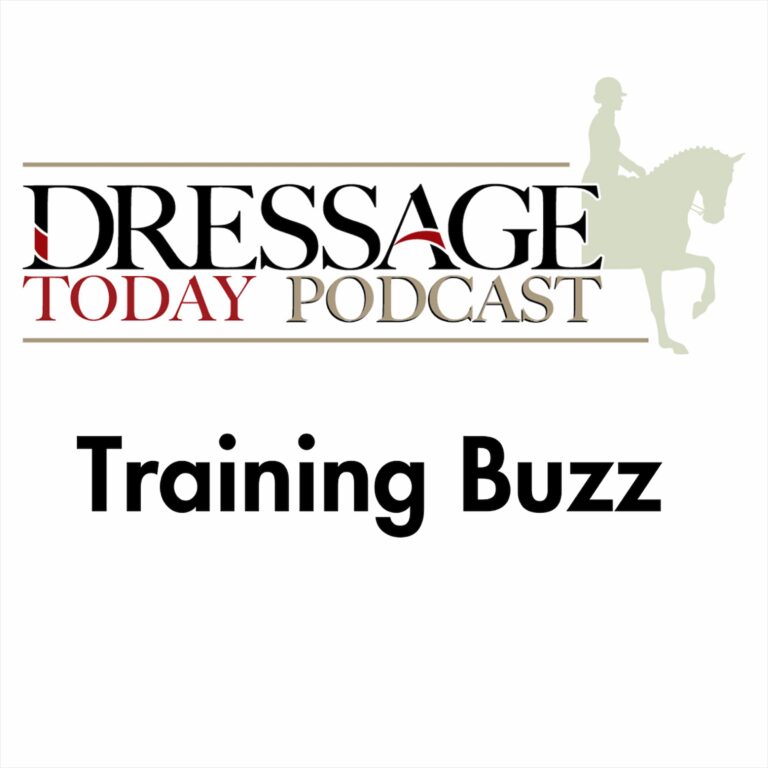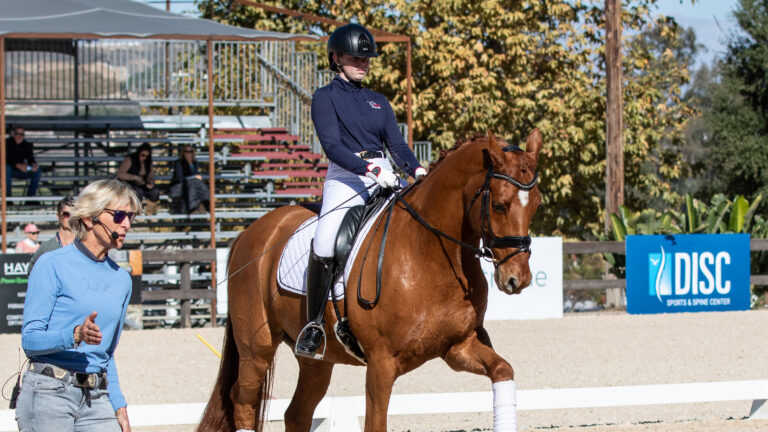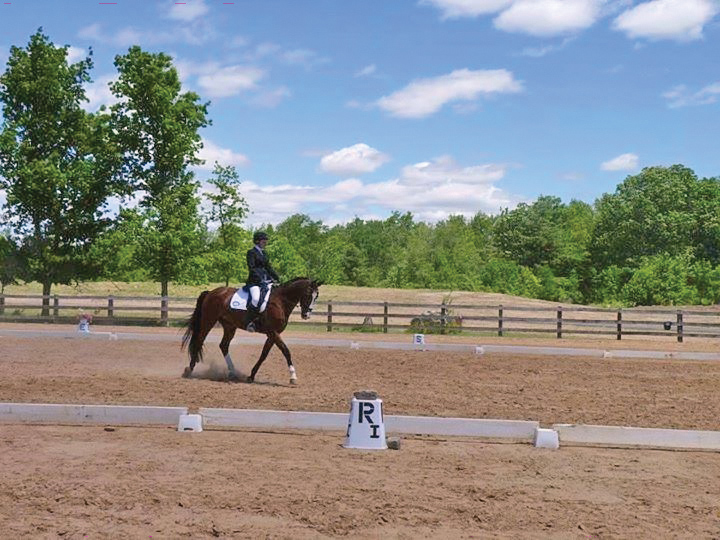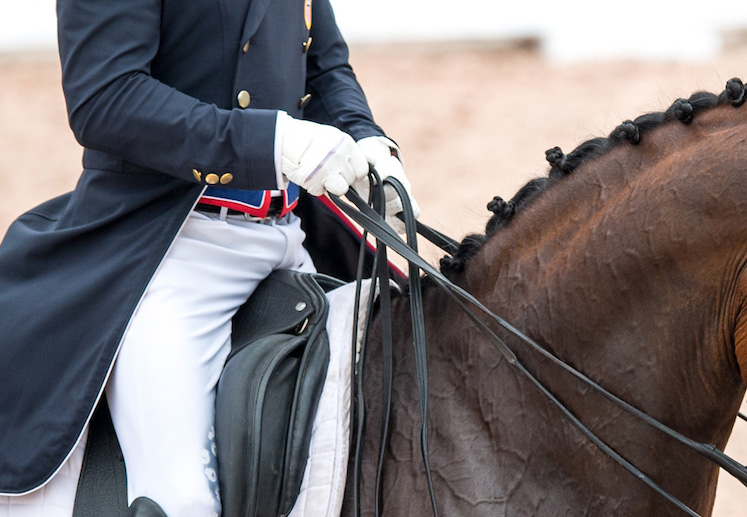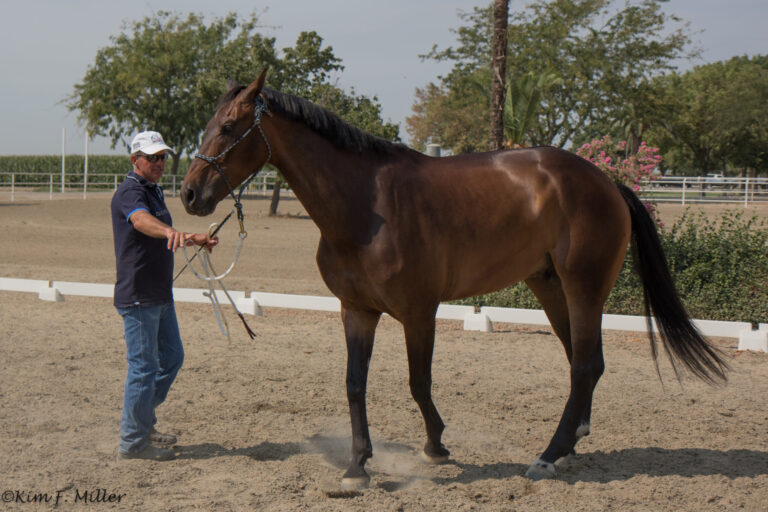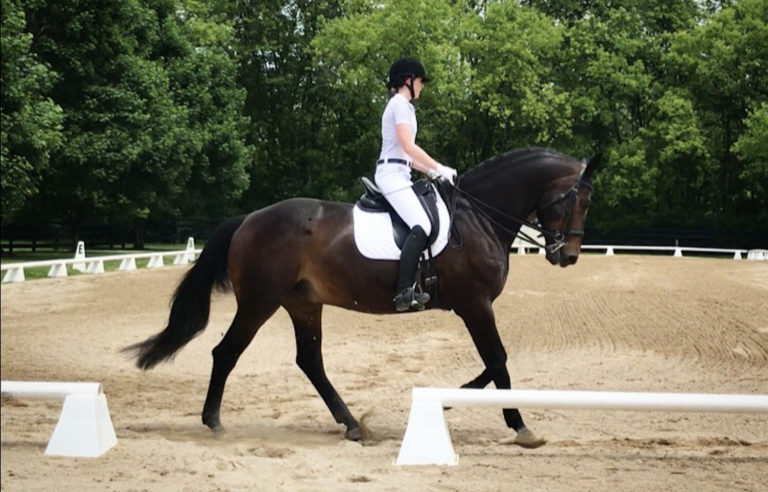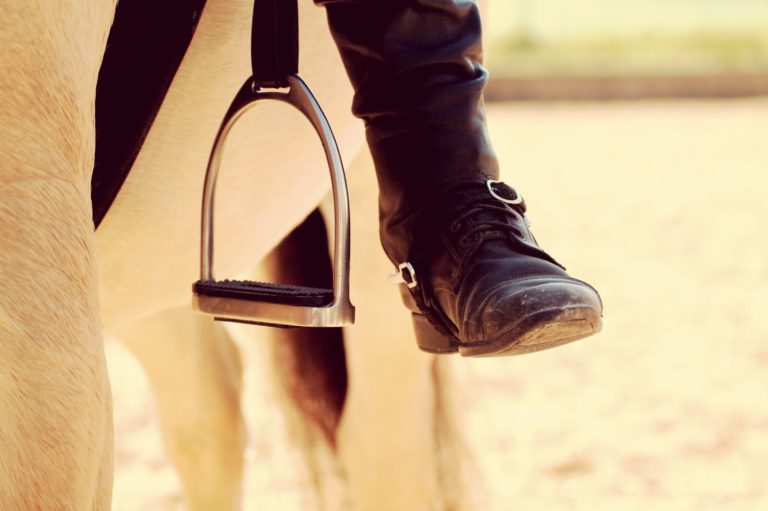Travers is a fancy name for a very down-to-earth movement, haunches-in, which is just that: As the horse travels in a straight line with his front legs, he bends his body to the inside, bringing his haunches in off the track.
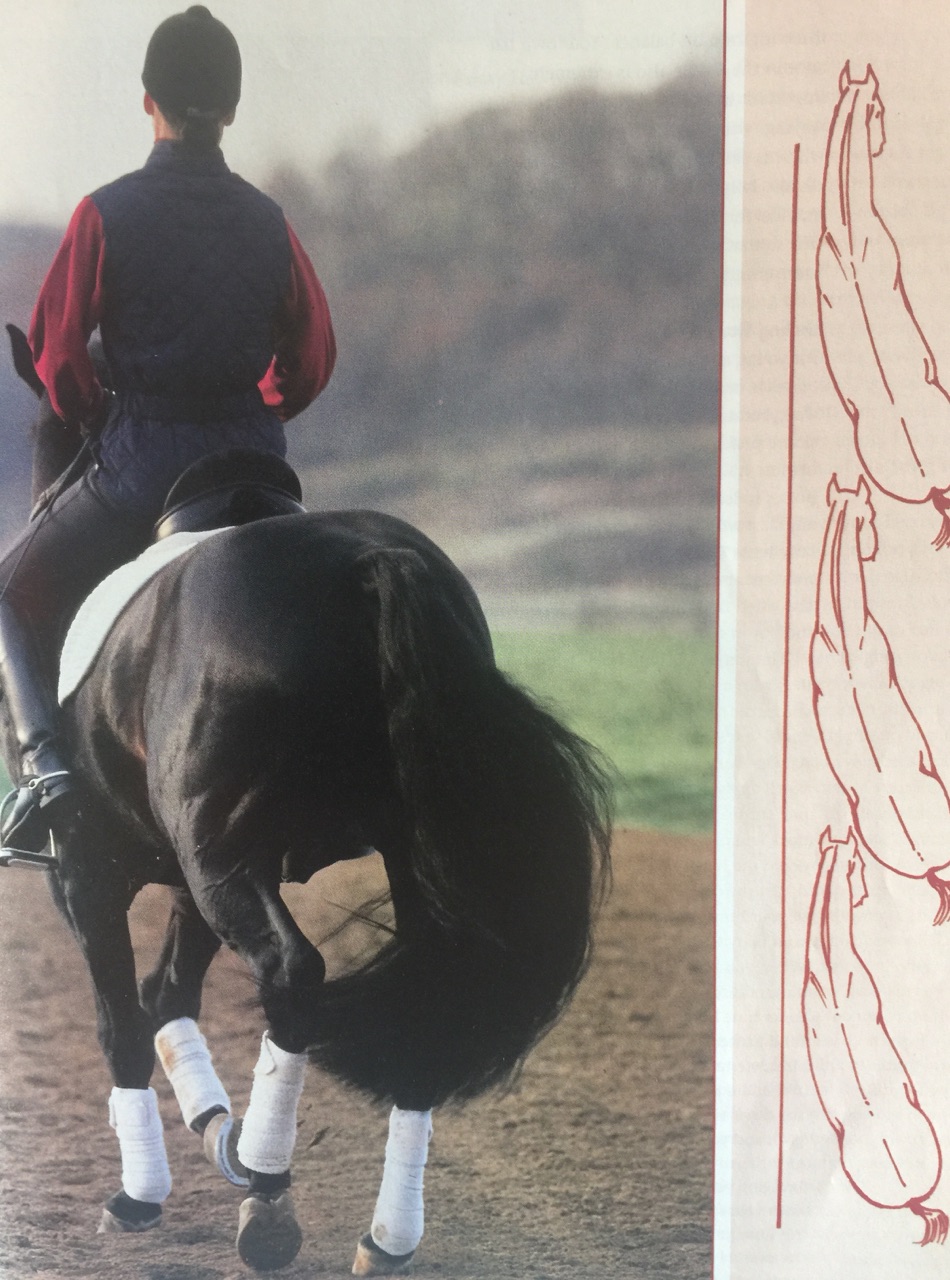
Viewed from in front or behind, he travels on three or four separate tracks, with his hind legs moving forward and sideways in a crossover fashion. The outside hind leg, which appears to cross in front of the inside hind leg, provides much of the driving power for the movement and takes on more of the horse’s weight by stepping increasingly sideways and under his body.
Introduced at Second Level, the travers is a good exercise for developing suppleness and collection, for correcting straightness problems and for tuning the horse to the rider’s aids. Because it requires the horse to bend in his body and work much harder with his outside hind leg, this exercise will strengthen his topline, back and hindquarters and encourage him to shift his weight backward, thus achieving more collection.
The travers also teaches the horse and rider two new concepts that will be invaluable in their later work, particularly in canter pirouettes and the half pass. The first is that, unlike in the leg yield where the horse is bent slightly away from the direction he’s traveling, in haunches-in, he bends toward the direction he’s traveling.
For instance, if he’s doing haunches-in to the left, with his haunches coming off the track to the left, his body bends to the left. This also is the first time the rider uses her outside leg as an active aid. Rather than supporting the bend in a passive way, the outside leg initiates the haunches-in movement, actively cueing the horse to move his hindquarters to the inside.
Basic Skills Needed
Before attempting the travers, you and your horse need to have acquired certain basic skills. He needs to be through: moving forward, round and accepting your aids. He must be competent in the leg yield and shoulder-in and demonstrate some respect for your outside aids. To test this, trot a circle and ask him to leg yield toward the inside of the circle, moving off your outside leg and hand.
You, too, need to be clear on the concept of riding forward. Impulsion is a key aspect in performing a good travers. You also need to have achieved enough independence in your leg, seat and hands that you can use each aid individually. In other words, you don’t want to accidentally use conflicting aids at the same time and risk confusing your horse or throwing him off balance. Your own balance in the saddle is extremely important in travers. If you have trouble staying “with” him, it’s easy to interfere with his ability to perform the exercise. It’s also helpful to have some knowledge and feel for the timing of the horse’s foot-falls so that you can time your own aids more effectively.
Getting Started
For young and/or inexperienced horses, travers is most difficult to learn at the walk, because it’s so easy to lose impulsion. I prefer to teach it at the trot or, because it’s sometimes even easier for horses to learn it in the canter, I occasionally start with that. Some horses, particularly tense thoroughbred types, figure that movement out faster at the canter. Riders also often find timing the aids easier with the slower canter rhythm.
The simplest way to teach haunches-in is with a 10- to 12-meter circle in the corner of the arena. As you complete the circle, you’ll maintain the forward pace. As your horse reaches the straightaway, you’ll apply a little more outside leg to prevent his haunches from reaching the track and continue the haunches-in down the long side of the arena.
On the circle, you’ll establish the bend of your horse and the basic position of your body that you’ll use in travers. When you leave the circle to begin the travers down the long side, you’ll have an easier time holding your horse’s hindquarters to the inside by using the already established bend from the circle.
Be sure to establish a good bend on the circle, using your inside leg at the girth and your outside leg behind the girth. Then increase the bend slightly by bringing your horse’s nose to the inside rein until you can see his nose just inside his shoulder. Prevent his outside shoulder from falling out by maintaining a steady contact with your outside rein and keeping your inside leg active. Over time, you’ll want your connection to your horse to shift from being primarily inside rein/outside leg to being primarily outside rein/inside leg.
As you start to move down the long side, try to time your outside leg aid so that you squeeze as your horse’s outside hind leg comes off the ground, thus encouraging it to cross over more. Otherwise, continue using the same bending aids (supple inside rein, steady outside rein and active inside leg) you had on the circle, adding a little extra inside leg pressure if he loses impulsion. His head and shoulders will remain on a straight line on the track.
Meanwhile, keep your head and upper body straight and facing forward, focusing your eyes down the length of the straightaway. Allow your inside hip to come forward slightly to match the forward angle of your horse’s inside hip, still feeling that your upper-body weight is in the center of your horse.
Upper-level riders incorporate a small weight shift to the inside hip in their cues for travers, however, this easily can be overdone. Less-experienced riders create many problems by focusing too much on this weight shift. At the early stages of learning, you need to think of sitting squarely in the saddle, without leaning or trying consciously to weight one hip more than the other. Concentrate on quietly following your horse’s motion rather than pushing it with your seat.
Although your horse’s front and hind legs are doing two different things, you must ride him with a strong feeling of connection. You need to feel a symmetrical bending through his body around your inside leg as well as an increase in power generated by his outside hind leg. This power must translate all the way through his body so he moves in one smooth, coordinated unit. To create this feeling, you need to coordinate and connect your own aids. Rather than thinking of riding his front end and hind end separately, think of using your legs, seat and hands in unison to ride him forward into the contact, connecting him from front to back and maintaining the bend throughout his body.
You need to maintain the tempo and impulsion of the trot (or canter) throughout the movement. With an inexperienced horse, you may have to slow the gait down slightly to allow him to find his own lateral balance initially, but don’t slow him down so much that you forfeit the quality of the gait.
At first, only expect three to six good steps of haunches-in. As he starts to lose the bend or crossover, straighten him back out on the track and praise him. Try the exercise again with another circle in the corner at the other end of the arena. Don’t overdo it, though. Young horses learn best if you make it fun for them, if they’re not fatigued and if you keep their minds fresh.
Don’t expect everything to be perfect at once, either. During one attempt, for instance, try focusing on maintaining a good bend, not worrying too much about how much crossover you’re getting. Then later, do the opposite, focusing on the crossover and not worrying quite so much about the bend. As he grows stronger, you can correct a haunches-in that’s not quite right by going back to a 10-meter circle, wherever you happen to be on the long side, reestablishing the bend and forward rhythm and then trying the haunches-in again as you come out of the circle.
As with all new movements, it’s best to ask for just a little at first and to praise you horse for even the smallest effort. As he begins to understand the concept and grows stronger in his hind-end, you gradually can ask for more steps, more bend and more collection. And, as he begins to understand the concept at the trot, if that’s the gait you started him in, try the travers at the canter as well, using the same technique. Eventually, with patience and consistency, you will be able to maintain a correct travers down most of the length of the long side in every gait.
The Aids
Dorie Addy-Crow, who has worked for me for nearly eight years, and Gambol, a 6-year-old approved Dutch stallion by Gabor and owned by George and Diane Fellows, demonstrate the outside and inside aids for travers.
Inside aids (below): Dorie’s inside leg is active at the girth to help reinforce the bend, and she holds a supple inside rein. Her inside hip comes slightly forward to match the forward angle of Gambol’s inside hip.

Outside aids (below): Dorie’s outside leg is behind the girth, and she holds a steady outside rein to keep Gambol’s outside shoulder from falling out.
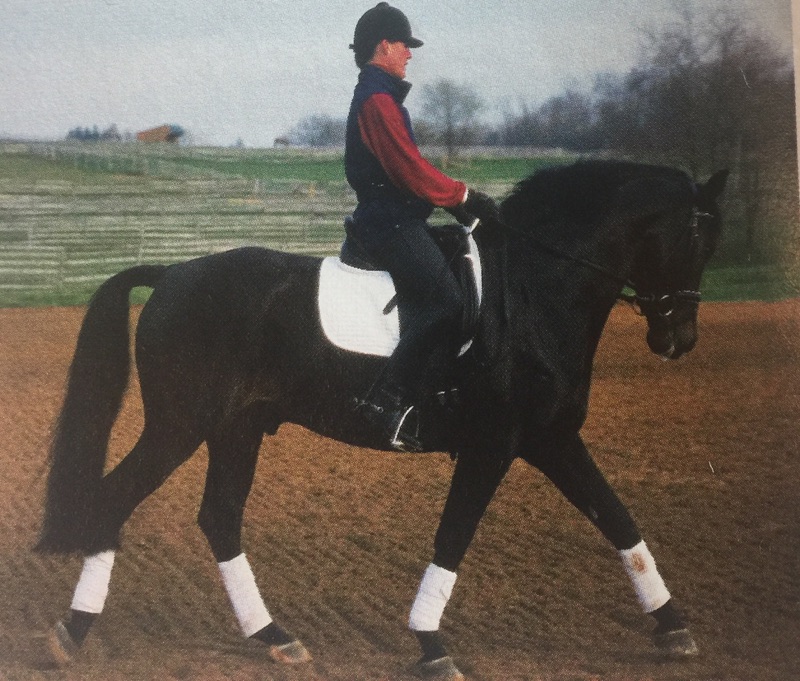
Teaching Travers
1. As my student, Ashley Fornell and her 8-year-old imported Dutch gelding, Kerido, by Burggraf, finish the circle and reach the straightaway to the long side, she applies more outside (left) leg to prevent his haunches from reaching the track.
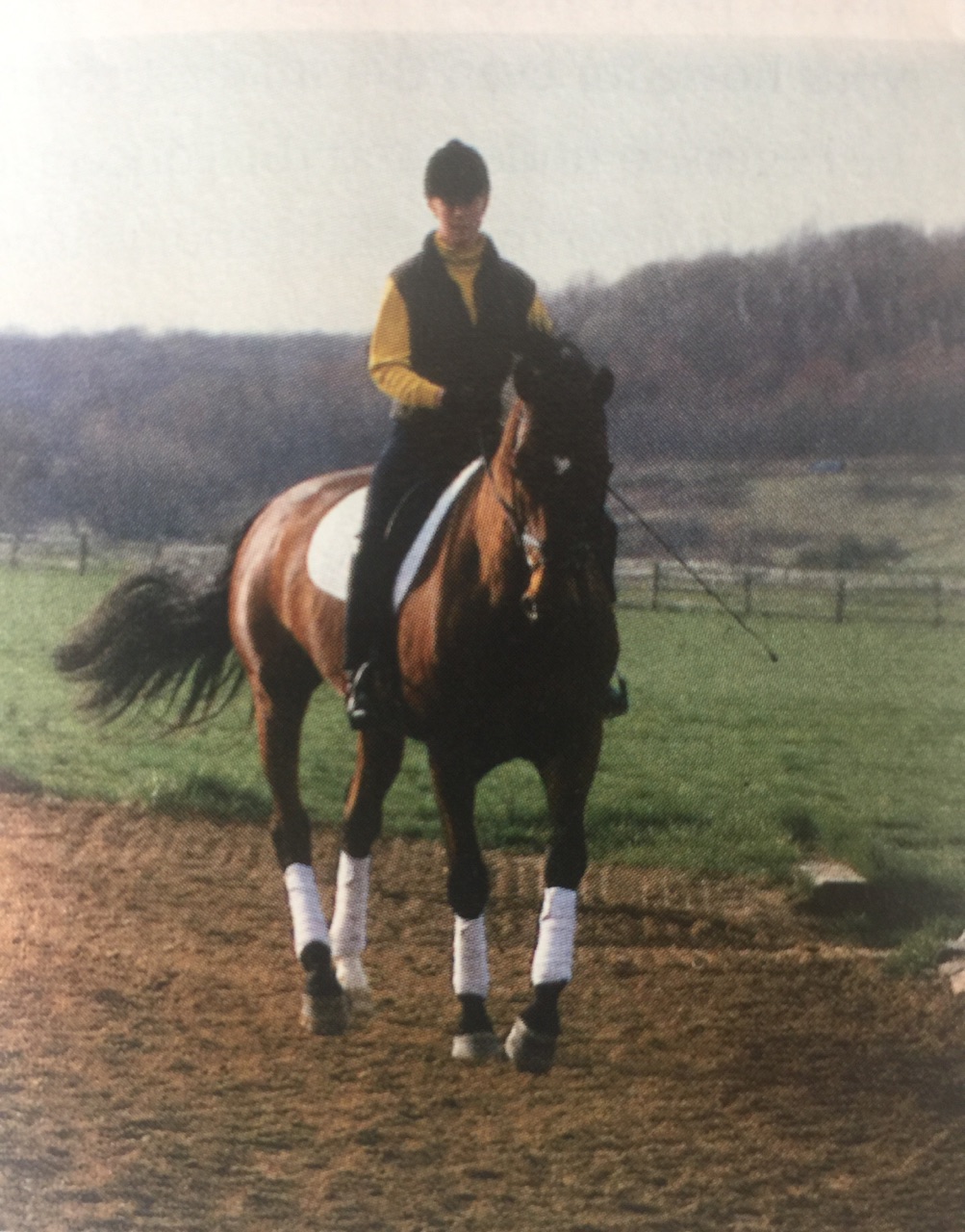
2. Ashley times her outside leg aid so she squeezes as Kerido’s outside leg comes off the ground, encouraging it to cross over more. She uses a supple inside (right) rein, steady outside rein and active inside leg.
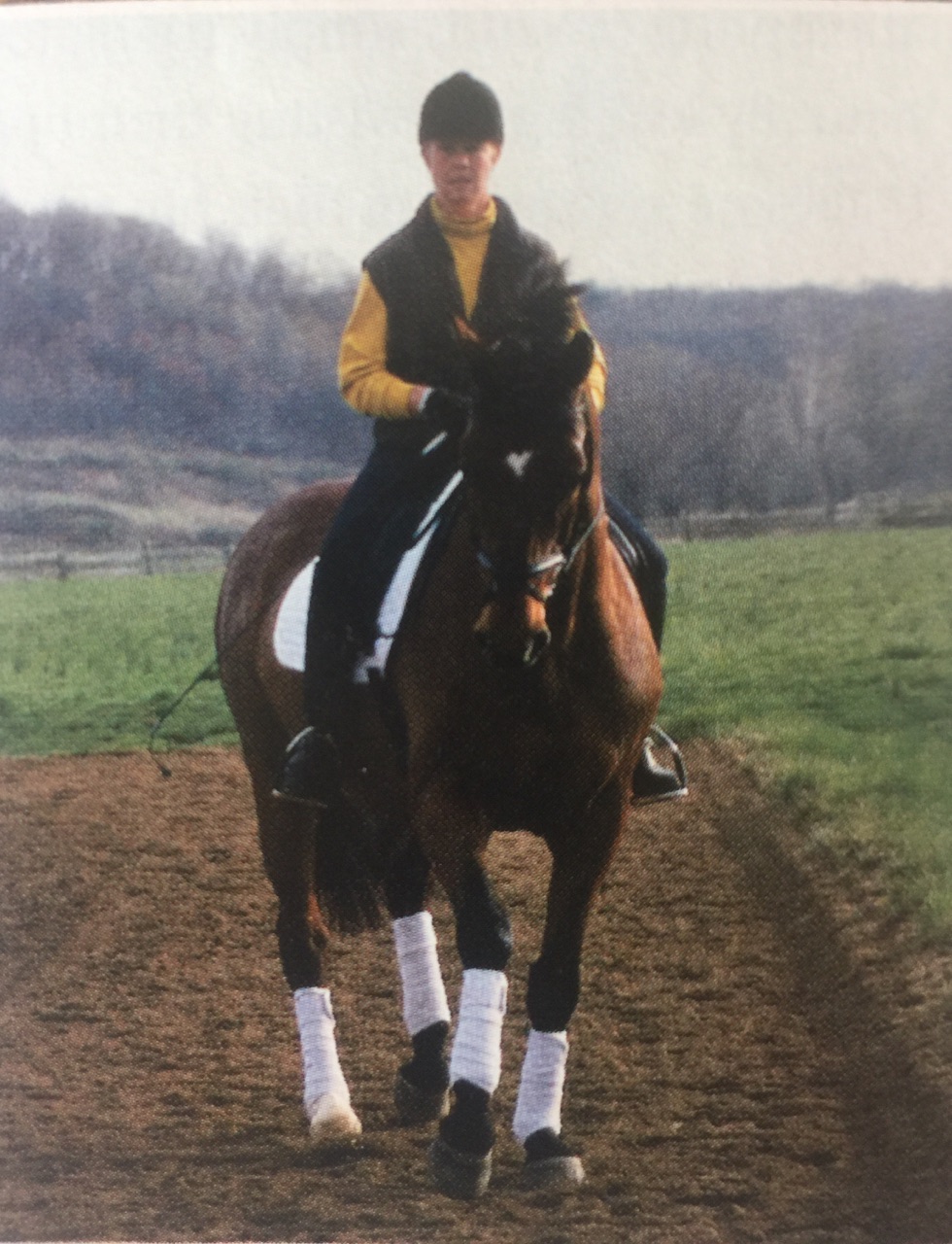
3. When Kerido started to lose the bend, Ashley straightened him and praised him. Next, she’ll try the exercise with another circle in the corner at the other end of the arena.
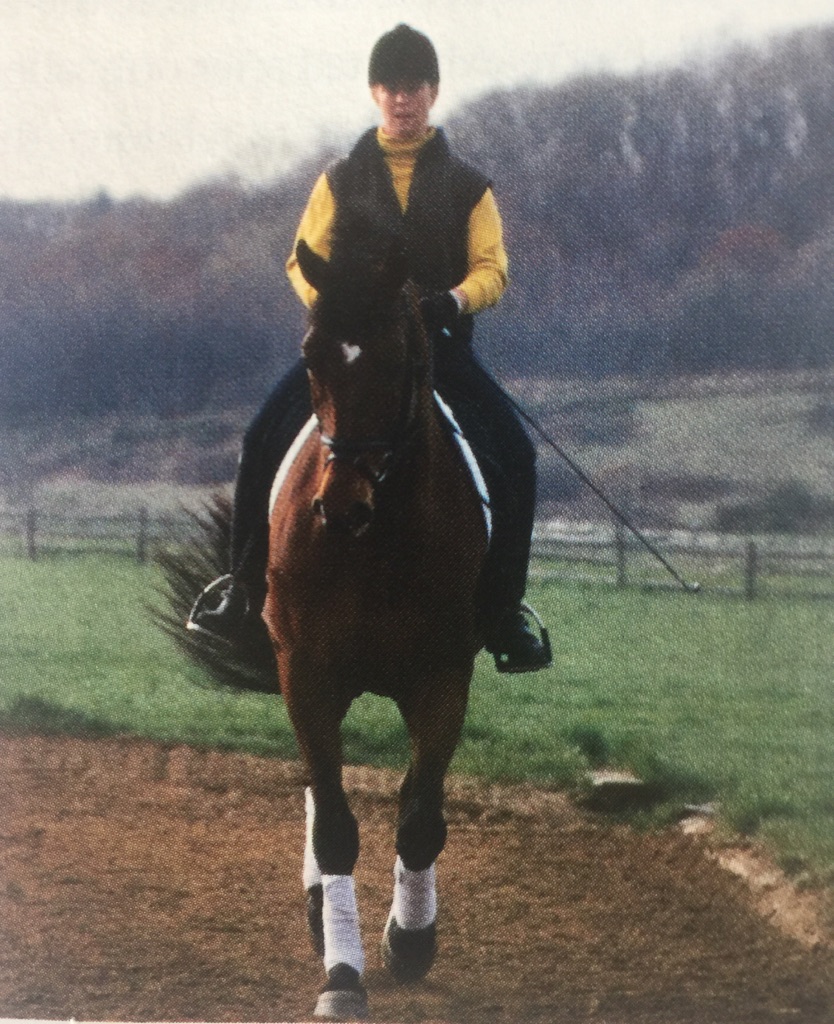
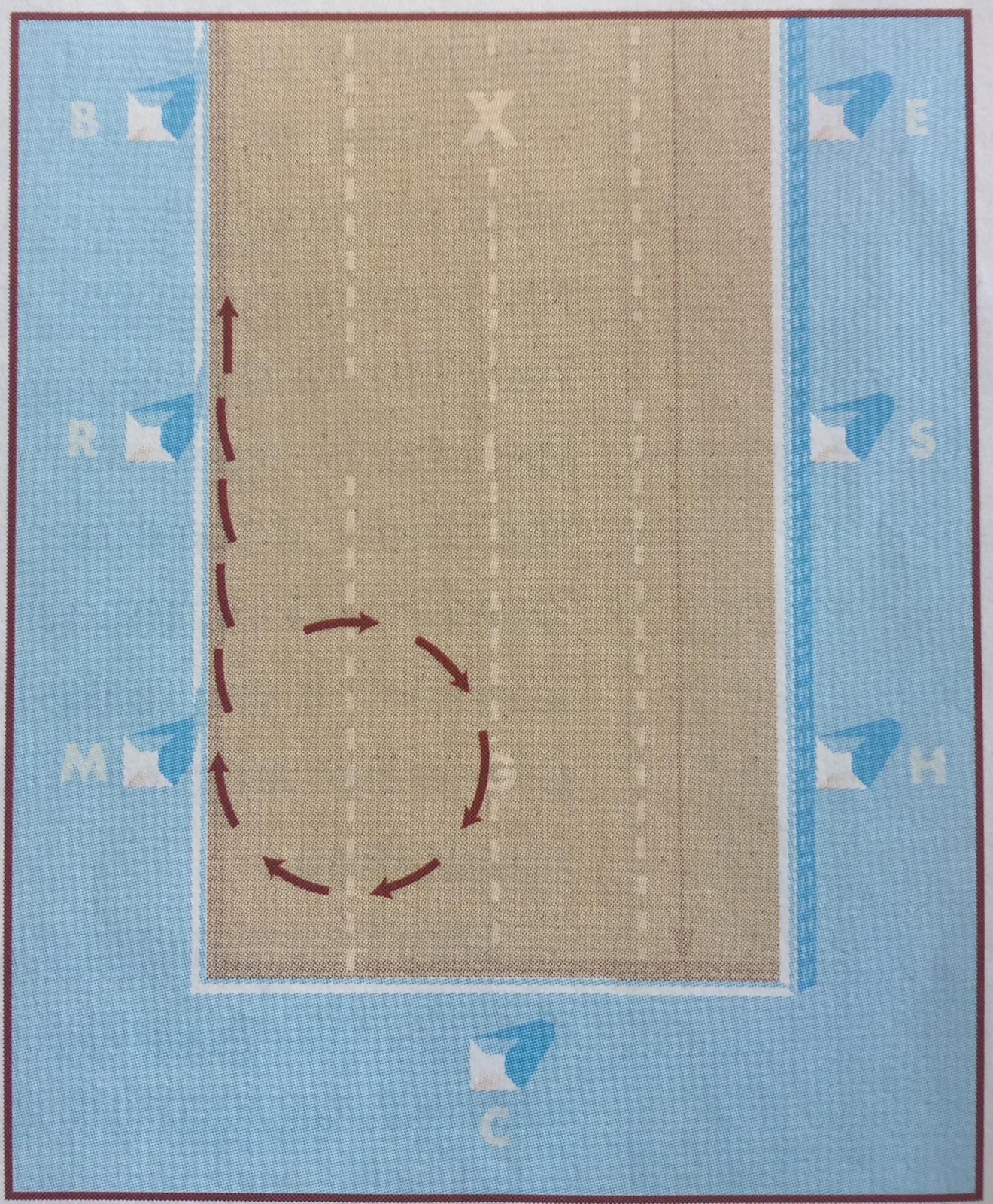
Troubleshooting
A big mistake that riders often make when first attempting travers is simply trying too hard. By leaning or twisting their upper bodies or exaggerating their hip movement, they try to help the horse move sideways. But, instead of helping the horse, this actually interferes with him by either blocking the direction of his movement or throwing him off balance. To prevent this from happening, concentrate on keeping your seat in the middle of the saddle, not trying to push him sideways with any exaggerated movements.
Riders also often overdo leg pressure. Thinking they have to work harder to maintain the greater bend in the movement, they squeeze and squeeze their legs until they’re exhausted after only about five minutes. You need to reinforce the bending in travers with an active inside leg, but you shouldn’t need to squeeze so much that your leg tires.
Below, Ashley is demonstrating a travers that is losing the bend. This can happen when the horse is not properly on the aids. To correct this, circle immediately and re-establish the bend and repeat the haunches-in as you come out of the circle.
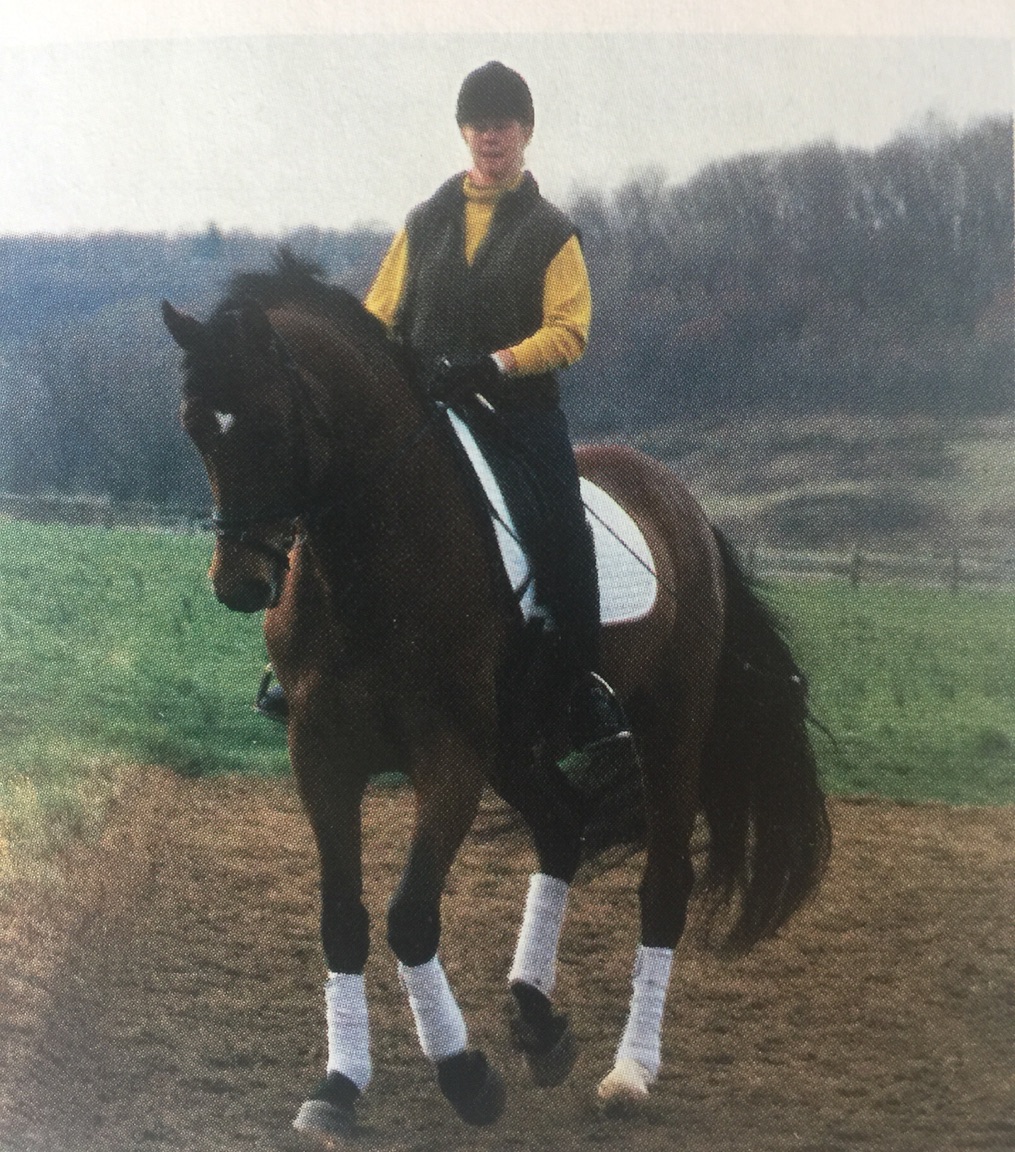
Below, Dorie is demonstrating a travers with too much bend, which can happen when you overuse the inside rein and outside leg without supporting the bend properly with the inside leg and outside rein. To correct this, maintain contact with the outside rein and keep the inside rein active.
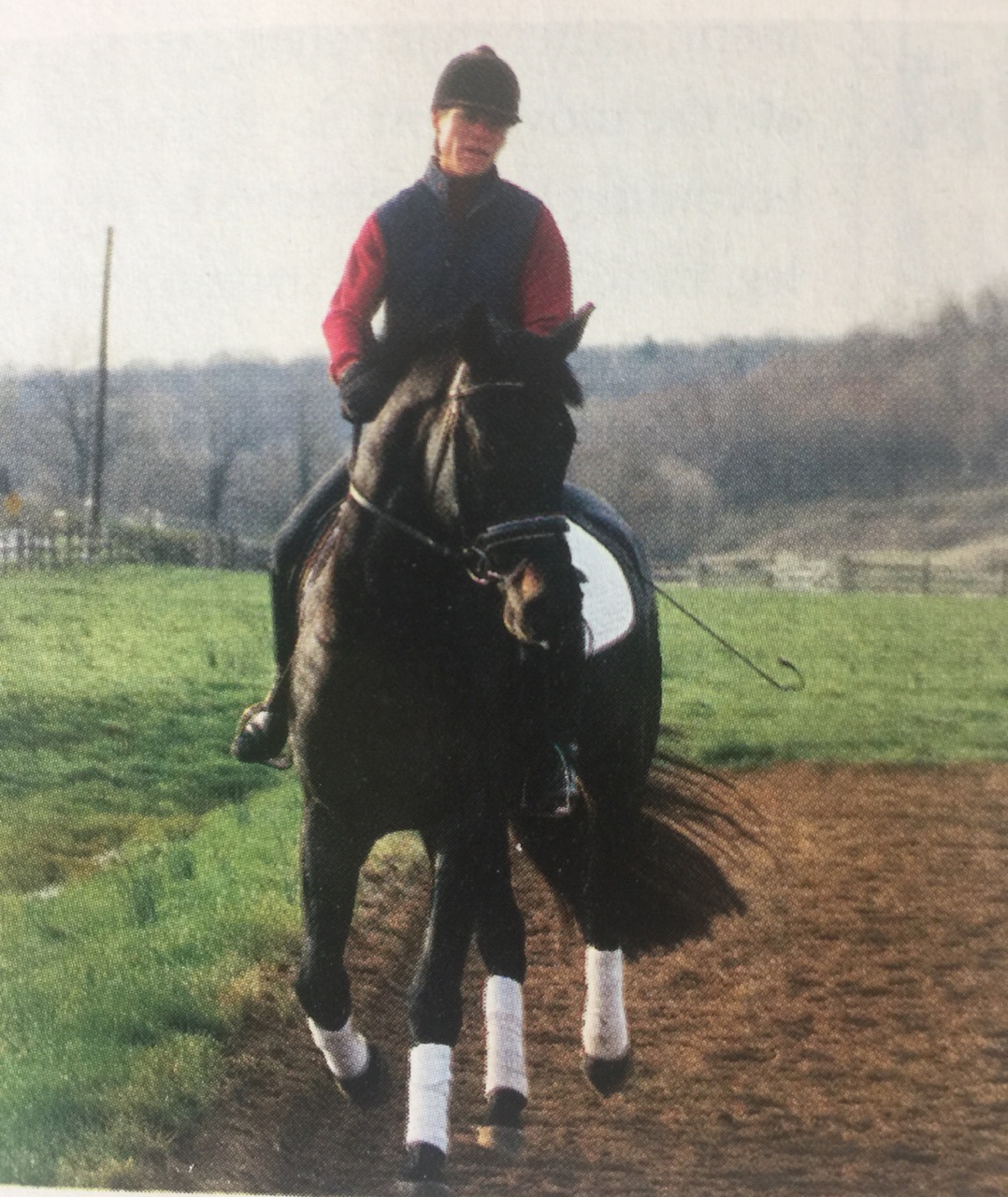
Some other common horse-and-rider mistakes include:
1. Rider holds too much rein contact. Inexperienced riders have a tendency to feel that they need to hold more rein contact to create the sideways movement and to help the horse maintain his bend and collection. This habit sometimes is a result of an unsteady rider trying to hold herself in the saddle. Unfortunately, it causes the horse to lose his impulsion and thus destroys the movement.
Correction: Both you and your horse have to learn to balance yourselves independently in lateral work, while still maintaining impulsion. So concentrate on your own balance and don’t try to “hold up” your horse. The less you interfere with him, the faster he’ll master his own balance. Work on improving the independence of your seat (by riding without stirrups, etc.) and be sure to maintain the same trot in haunches-in that you had on the straightaway and circle.
2. Rider uses too much inside rein. Though the cues for travers include the inside rein and outside leg, if you overdo these aids without supporting the bend properly with the inside leg and outside rein, you’ll throw the horse’s balance onto his outside shoulder.
Correction: Always maintain contact with the outside rein and keep your inside leg active. This outside rein/inside leg connection is your eventual goal in all of your work.
3. Horse not properly on the aids. Traveling with a hollow back and not accepting the aids, the horse cannot properly bend his body and step under it with his outside hind leg.
Correction: Check his bend on the circle and exaggerate it slightly before beginning the haunches-in. Be sure to maintain a steady contact with your outside rein to support the bend. If he loses the bend during the movement, circle immediately, wherever you are on the long side, reestablish the bend, and then repeat the haunches-in again as you come out of the circle.
4. Not enough crossover. Horses that are stiff or lazy behind tend to volunteer less crossover in the haunches-in. The good news is, the movement itself will strengthen these horses and improve their hind-end activity with practice.
Correction: Be sure to start the movement with a very active trot and maintain that activity throughout the movement. When he becomes sluggish, make a circle as I described in number three above to reactivate his hind end before going back to the movement. I reserve the spur or whip to intensify a movement, rather than relying on them to create the movement. So, if you horse is becoming less responsive to your outside leg, instead of using stronger spurs or whip, try this exercise:
If you’re traveling to the right in travers, immediately turn the movement into a leg-yielding exercise, asking him to move off your old outside/new inside (left) leg and rein. Either do this on the straightaway or make a 20-meter circle, leg yielding toward the center of the circle off your left leg. Exaggerate the bending, which is now to the left a little bit. This will put him a little off balance and cause him to move away from your left aids, thus reminding him to associate those aids with a sideways movement. This will help sharpen his response to your aids in travers well.
5. Not enough bend. This can result in too much crossover and an immediate loss of impulsion. If a horse doesn’t have enough bend in his body, he’ll be stiff in his back and spine and will move sideways with both his front and hind legs, essentially performing a leg yield rather than a haunches-in.
Correction: To correct this, you’ll need to improve both the bend and the impulsion. Go back to your circle and reestablish both before attempting the movement again. When you try the movement, focus more on his bend and impulsion than his degree of crossover.
By following this methodical system for teaching your horse to do travers confidently, you’ll give yourself an invaluable tool to increase his suppleness and straightness, as well as prepare him for upper-level work.
This issue first appeared in the June 2000 issue of Dressage Today magazine. Please note that we require featured riders to wear helmets in all current issues of Dressage Today.
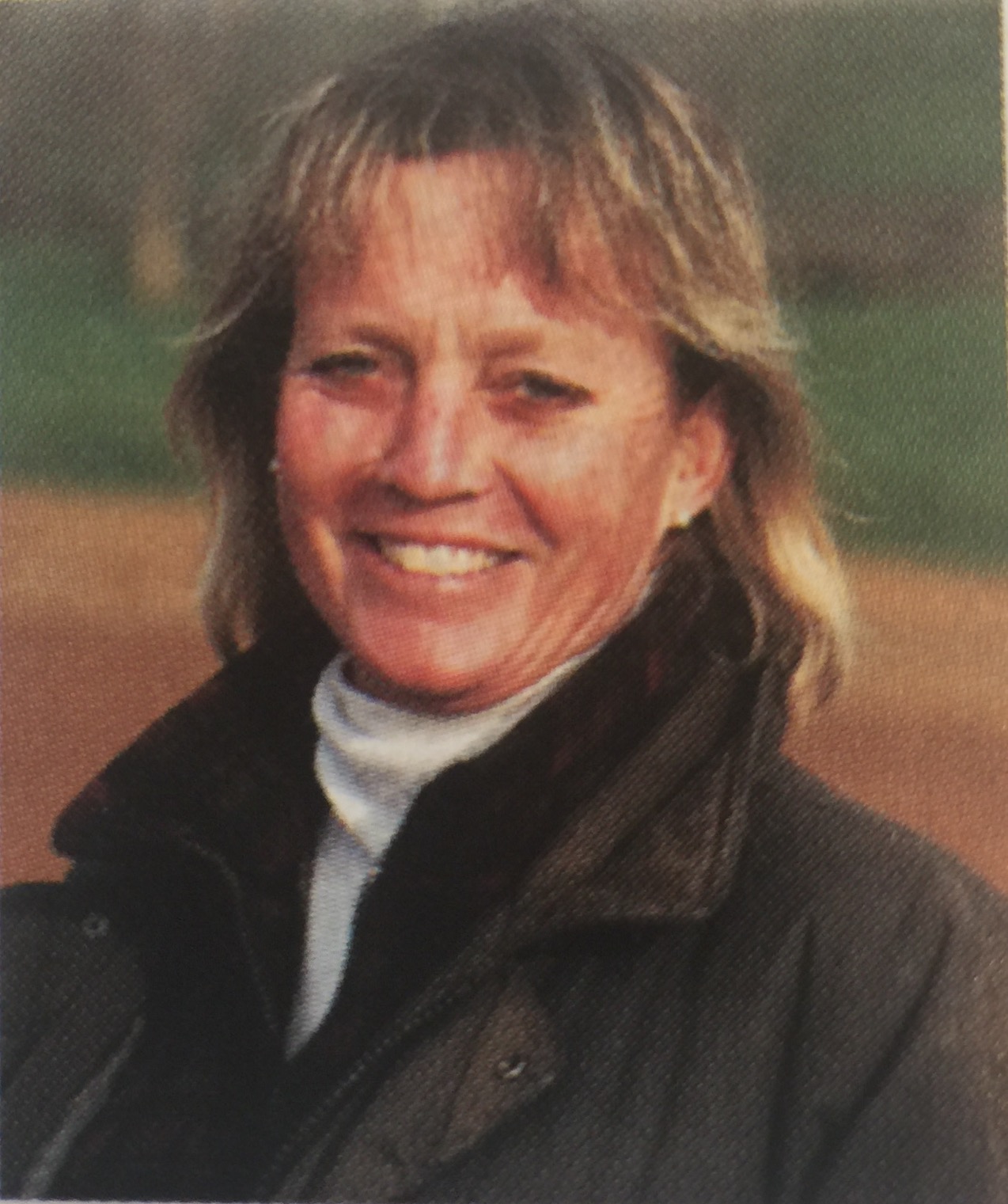
Belinda Nairn-Wertman represented the U.S. Equestrian Team at the 1984 Olympics with the Hanoverian mare Alegria and at the 1988 Olympics with the Dutch Warmblood gelding Christopher. Winner of several national championships with a number of horses over the years, she also won the 1991 U.S. Olympic Festival with Zodiac, another Dutch horse. This year, she will introduce her 1999 Pan-American trials partner, Sorcerer, a Dutch Warmblood gelding, to the Grand Prix level. Based at her Kirkwood, Pennsylvania, farm where she and her husband, Bill Wertman, also run a training, sales and breeding farm, Nairn-Wertman travels to Europe eight to nine times a year, importing approximately 50 horses annually for clients of her business, Inspo, Inc.


